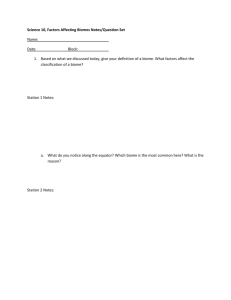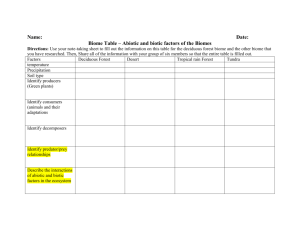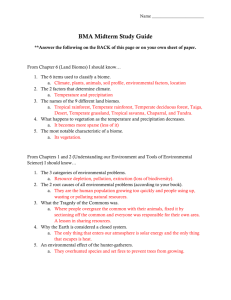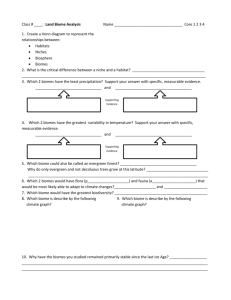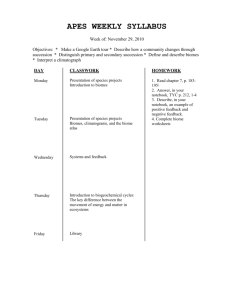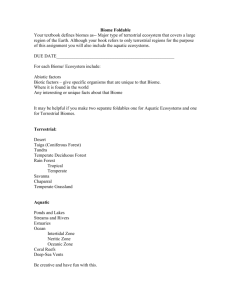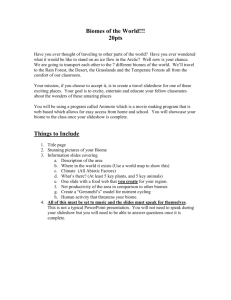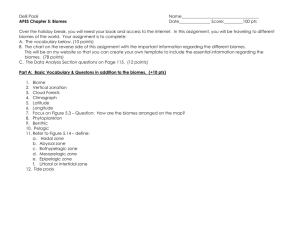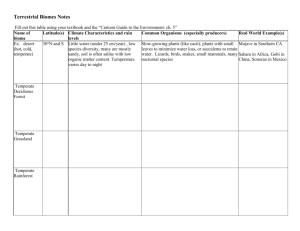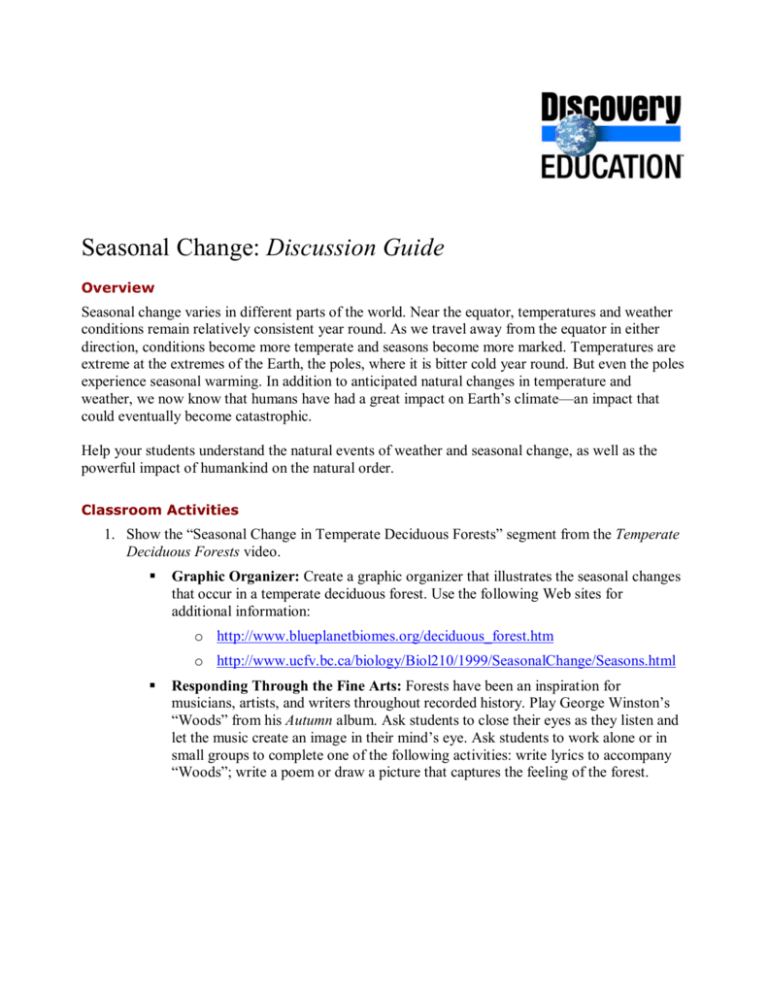
Seasonal Change: Discussion Guide
Overview
Seasonal change varies in different parts of the world. Near the equator, temperatures and weather
conditions remain relatively consistent year round. As we travel away from the equator in either
direction, conditions become more temperate and seasons become more marked. Temperatures are
extreme at the extremes of the Earth, the poles, where it is bitter cold year round. But even the poles
experience seasonal warming. In addition to anticipated natural changes in temperature and
weather, we now know that humans have had a great impact on Earth’s climate—an impact that
could eventually become catastrophic.
Help your students understand the natural events of weather and seasonal change, as well as the
powerful impact of humankind on the natural order.
Classroom Activities
1. Show the “Seasonal Change in Temperate Deciduous Forests” segment from the Temperate
Deciduous Forests video.
Graphic Organizer: Create a graphic organizer that illustrates the seasonal changes
that occur in a temperate deciduous forest. Use the following Web sites for
additional information:
o http://www.blueplanetbiomes.org/deciduous_forest.htm
o http://www.ucfv.bc.ca/biology/Biol210/1999/SeasonalChange/Seasons.html
Responding Through the Fine Arts: Forests have been an inspiration for
musicians, artists, and writers throughout recorded history. Play George Winston’s
“Woods” from his Autumn album. Ask students to close their eyes as they listen and
let the music create an image in their mind’s eye. Ask students to work alone or in
small groups to complete one of the following activities: write lyrics to accompany
“Woods”; write a poem or draw a picture that captures the feeling of the forest.
Hometown Biome: Tell students that a biome is a region characterized by its plant
life and climate. A temperate deciduous forest is an example of a biome. Have
students research the biome in which they live. Students can visit the following Web
sites to determine the biome they live in and to obtain additional information about
their biome.
o http://www.worldbiomes.com/biomes_map.htm
o http://animal.discovery.com/guides/mammals/habitat/map.html
o http://www.blueplanetbiomes.org/world_biomes.htm
o http://earthobservatory.nasa.gov/Laboratory/Biome/biotemperate.html
2. Show “The Tropics: Seasonality and Precipitation” segment from the Climates,
Landscapes and Life: The Tropics video. (Access to unitedstreaming is required.)
Build a Model: Have students investigate seasonal change in one of the three
climatic zones of the world: the tropical region, the mid-latitude or temperate region,
and the sub-arctic or polar region. Then ask them to build a model that shows the
seasonal changes. Students can use clay, cardboard, paper, fabric,
newspaper/magazine clippings, or other materials. See
http://www.blueplanetbiomes.org/climate.htm for information on climatic zones.
Brainstorming: The tropics are divided into different regions based on amount of
rainfall. As a result, each is home to different forms of plant and animal life. Have
students brainstorm a list of plants and animals that might live in each of the
following regions: the rainy tropics, the wet-dry monsoon tropics, the tropical and
sub-tropical deserts, and the tropical highlands. Use the chalkboard to record student
responses. Students can use the following Web sites to check the accuracy of the list.
o <http://curriculum.calstatela.edu/courses/builders/lessons/less/biomes/rainfor
est/tropi_rain/rainweb.html>
o http://www.evergladesplan.org/facts_info/sywtkma_animals.cfm
o http://www.blueplanetbiomes.org/med_chaparral.htm
o http://www.wettropics.gov.au/pa/pa_default.html
o http://lead.virtualcentre.org/en/dec/toolbox/Grazing/TempTrop.htm
o http://www.friendsofsaguaro.org/plants.html
o http://www.friendsofsaguaro.org/animals.html
Tropical Rainforests and You: Ask students to describe how important tropical
rainforests are to humankind. Following a brief discussion, tell students to read the
facts presented on this Web site:
http://www.cnr.vt.edu/boyer/geog1014/TOPICS/102Climate/tropics/tropics.htm.
Then have them write a journal entry or personal essay about what losing a rainforest
means to them.
Published by Discovery Education. 2006. All rights reserved.
3. Show the “Our Changing Climate: Researching and Forecasting Weather” segment from the
Biomes: Extreme Climate video. (Access to unitedstreaming is required.)
Pre-Viewing Discussion: Before watching the video, ask students what they know
about global warming and the greenhouse effect. Questions to consider include the
following: How serious is global warming? How does it affect our lives today? How
will it affect our lives in the future? Next, have students test their knowledge by
completing an online quiz prepared by the U.S. Environmental Protection Agency.
Visit http://yosemite.epa.gov/ oar/globalwarming.nsf/content/impacts.html and click
on “Test Your Knowledge.”
Public Service Announcement: The video discusses some of the potential dangers
of global warming. Have small groups of students prepare public service
advertisements that inform the public of these dangers. Share the ads with the student
body to educate everyone about the issues. Ads can be in video, print, or audio
format. Students can visit the following sites for more information:
o http://www.time.com/time/2001/globalwarming/splash.html
o http://www.nrdc.org/globalWarming/default.asp
o http://pubs.acs.org/hotartcl/cenear/951127/pg1.html
Find a Solution: Have students research possible solutions to the problem of global
warming, focusing especially on what they can do at home and in their own lives to
combat the problem.
Map It: The segment mentions three hot spots of dramatic climate change: the
Western Arctic (north of Alaska and Canada), the Antarctic (the tip of land that
sticks out toward South America), and the Siberian Arctic. Have students look at a
map or a globe to find these locations.
4. Show the “Melting Polar Ice Caps and Glaciers: Drastic Change Ahead” segment from the
Biomes: Extreme Climate video. (Access to unitedstreaming is required.)
Climate Glossary: Have students make a list of unfamiliar words as they watch the
video. After watching the video, have students look up the terms in a dictionary or
encyclopedia. The following words might be unfamiliar: ecosystem, habitat, species,
organisms, environment, coastal erosion, thermal expansion, barometer.
Politics and Global Warming: The video shows a clip of a press conference with
President Bush in which he states that he will not put a cap on carbon dioxide (CO2)
emissions if it will hurt the economy. Have students visit
http://www.globalwarming.org/politics_archive.htm to research other political
decisions that might have an effect on climate.
Published by Discovery Education. 2006. All rights reserved.
Post-Viewing Discussion: After viewing the video, have students discuss the impact
of humans on world climate. Ask them if they are surprised by the drastic changes
that scientists are predicting. Have students consider the impact of the following
facts mentioned in the video: the sea level is expected to increase by three meters;
half of the Alpine glaciers are expected to disappear; 70 to 80 percent of the icebased ecosystems in the Arctic are expected to disappear; the ice caps may disappear
by the year 2050.
Academic Standards
Mid-continent Research for Education and Learning (McREL)
McREL’s Content Knowledge: A Compendium of Standards and Benchmarks for K-12 Education
addresses 14 content areas. To view the standards and benchmarks, visit
http://www.mcrel.org/compendium/browse.asp.
This lesson plan addresses the following national standards:
• Working With Others
o Contributes to the overall effort of a group
• Science
o Places and Regions
Understands the concept of regions
o Uses of Geography
Understands global development and environmental issues
• Language Arts
o Writing: Uses the general skills and strategies of the writing process; Gathers and
uses information for research purposes
o Reading: Uses reading skills and strategies to understand and interpret a variety of
informational texts
o Viewing: Uses viewing skills and strategies to understand and interpret visual media
o Listening and Speaking: Uses listening and speaking strategies for different purposes
The National Council of Teachers of English (NCTE)
The National Council of Teachers of English and the International Reading Association have
developed national standards to provide guidelines for teaching the English language arts. To view
the standards online, visit www.ncte.org/about/over/standards/110846.htm
This lesson plan addresses the following English standards:
• Students conduct research on issues and interests by generating ideas and questions, and
by posing problems. They gather, evaluate, and synthesize data from a variety of sources
(e.g., print and non-print texts, artifacts, people) to communicate their discoveries in
ways that suit their purpose and audience.
• Students adjust their use of spoken, written, and visual language (e.g., conventions, style,
vocabulary) to communicate effectively with a variety of audiences and for different
purposes.
Published by Discovery Education. 2006. All rights reserved.
•
Students use a variety of technological and information resources (e.g., libraries,
databases, computer networks, video) to gather and synthesize information and to create
and communicate knowledge.
National Council for the Social Studies
The National Council for the Social Studies (NCSS) has developed national standards to provide
guidelines for teaching social studies. To view the standards online, go to
http://www.socialstudies.org/standards/strands/.
This lesson plan addresses the following thematic standards:
• Time, Continuity, and Change
• People, Places, and Environments
• Individuals, Groups, and Institutions
• Power, Authority, and Governance
Published by Discovery Education. 2006. All rights reserved.

